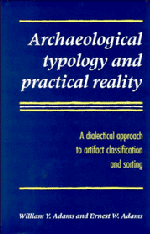 Archaeological Typology and Practical Reality
Archaeological Typology and Practical Reality Published online by Cambridge University Press: 23 November 2009
In its early days the Typological Debate was somewhat beclouded by the lack of an adequate conceptual vocabulary, a problem that has been common to all sciences in their formative stages. Commentators like Rouse (1939; 1960), Krieger (1944), Brew (1946: 44–66) and Taylor (1948: 113–51) had to use too few words to mean too many things, and it is not surprising that their ideas were not always expressed very precisely. They rarely distinguished between entities and concepts, between variables and attributes, between classifying and sorting, or between typology and taxonomy.
Lack of an adequate vocabulary is no longer the problem that it once was. In some respects we now have more conceptual terminology than we can reasonably use. Many typologists in the last thirty years have attempted to solve the stubborn problems of artifact classification, or to reduce the gap between theory and practice, by offering new conceptual formulations. Unfortunately these have often been expressed in the form of false dichotomies, as we will see later in the chapter, and their effect has at times been to further becloud the Typological Debate rather than to clarify it.
The problem today is not so much one of inadequate conceptual tools, as of tools unused or unsystematically used. In this chapter we will consider a number of persistent problems with regard to classification and typology whose basis is at least partly conceptual.
To save this book to your Kindle, first ensure [email protected] is added to your Approved Personal Document E-mail List under your Personal Document Settings on the Manage Your Content and Devices page of your Amazon account. Then enter the ‘name’ part of your Kindle email address below. Find out more about saving to your Kindle.
Note you can select to save to either the @free.kindle.com or @kindle.com variations. ‘@free.kindle.com’ emails are free but can only be saved to your device when it is connected to wi-fi. ‘@kindle.com’ emails can be delivered even when you are not connected to wi-fi, but note that service fees apply.
Find out more about the Kindle Personal Document Service.
To save content items to your account, please confirm that you agree to abide by our usage policies. If this is the first time you use this feature, you will be asked to authorise Cambridge Core to connect with your account. Find out more about saving content to Dropbox.
To save content items to your account, please confirm that you agree to abide by our usage policies. If this is the first time you use this feature, you will be asked to authorise Cambridge Core to connect with your account. Find out more about saving content to Google Drive.